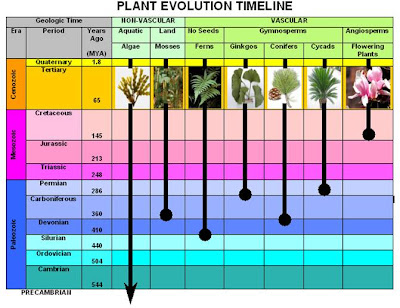Plants - did they all start together?
No! The earliest fossils of plants were just traces of algae that lived approximately 3,000 million years ago and are thought to be the first primitive relatives of all plant life on earth.
To give an idea of the time scale - here is a picture that explains the evolution of the different types of plants and when they first appeared on earth.
 |
| The Plant Time Line |
These algae who started life in the Pre Cambrian period didn't arrive on land until about 400 million years ago, so this first stage took some 2,600 million years. Many land plants were still basic algae which didn't survive - but others which are the ancient relatives of the mosses and liverworts did survive. The basic plant kingdom time line of evolution is shown here:
 |
| Basic Plant Kingdom |
As you can see at the start was algae (which itself developed further) until the liverworts and mosses arrived. So 400 million years ago there were no trees, ferns, flowers at all. Just some mosses and liverworts - very tiny along with algae. The liverworts and mosses then were just multicellular tissue grouping that photosynthesised. (Another story). Then 55 million years later there was a change to these multicellular plants - they developed specialised water conducting cells with the plant body. The ancestors of these first specialised developed tissue plants are called the clubmosses, horsetails and ferns. These were the first true image of what we recognise today as plants. They had roots, stems and leaves, and the relatives of these are common today and remarkably unchanged. This all happened 345 million years ago. It was another 120 million years until the next big change occurred - the arrival of the first true seed bearing plants.
This was 225 million years ago, and they are the relatives of our conifers (pine trees etc) and cycads - sometimes called cone bearing plants. This period lasted some 90 million years until the glorious flowering plants arrived for the first time and now is the largest plant group on earth. They cover trees, shrubs, grasses, vines, weeds and nearly every plant we normally see from day to day.
The development of each of the above groups will be discussed separately. Overall they are nearly 400,000 different plant species on earth the have been discovered so far and growing rapidly each year.


I see that this was posted in 2012, so you might not see this comment, but I wanted to say THANK YOU. I am covering botany for homeschool and this was a great illustration of a timeline of plant life.
ReplyDelete2020 *sunglasses emoji*
Deleteyou are antonio
Deleteso cool 😎
ReplyDeleteyyyyytuuuuuuuuuuuuuuuuuu
ReplyDelete